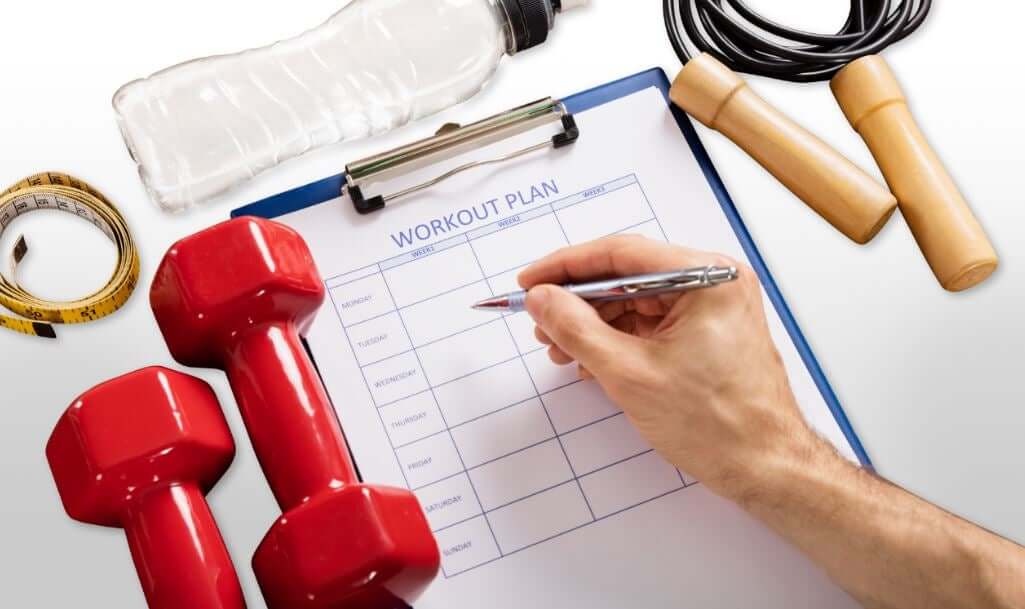Keys to Success in Resuming Training

After a period of rest, it’s time to get back to the old routines. It’s easy to say this is straightforward, but resuming training in the real world is often not so simple.
To resume training after a very pleasant vacation, you need more than just desire and willpower. Discipline, order, and consistency are part of the keys that guarantee success.
Resuming training: a comprehensive plan
We seldom take it into account, but it’s important when planning training not to forget that leisure periods are always there. There are even those who go further and point out that these days of doing nothing or radically changing routines are absolutely necessary. It’s a question of health and wellbeing.

Therefore, going one, two, or even three weeks without exercising has to be part of the general planning of a whole year. In addition, the body and mind will most likely end up appreciating this space to ‘disconnect’ from ordinary work.
Don’t overindulge in what you eat
What you shouldn’t change radically during these holidays are some habits. The most important of all: food. Even on vacation, you must eat in moderation.
It’s true that part of the charm of the vacations is eating many dishes that are usually ‘forbidden’ during the rest of the year. However, it’s not about giving yourself permission to eat whatever you want, whenever you want.
This is an aspect that goes beyond concepts such as staying in shape or avoiding being overweight. Eating only foods that don’t add anything positive to the body for one, two, or three weeks isn’t consistent with a global physical training plan.
Resuming training: have clear and realistic goals
Whether it’s a question of starting from scratch or resuming training, the objectives you set must be realistic. In no case is it possible to meet goals such as losing 25 pounds in a month.
These types of unrealistic goals are the first step in the failure of fitness plans. In fact, they’re often more counterproductive than no specific goal at all.
Every goal should be perfectly measurable and verifiable over not too long periods of time. Examples are to lose two pounds per week or to walk 20 minutes at first, three times per week for a month. Once you’ve reached these goals, it’ll be time to increase the levels of demand.

One step at a time
Even professional athletes, after a period of inactivity, gradually begin to resume training. This is because the body, even when it’s accustomed to high levels of physical demand, needs to readapt progressively.
Those who practice sports for pleasure or fun should also respect this rule. The most widespread recommendation in this regard is to reduce training routines that were being performed before the ‘break’ by half.
So, let’s say a running enthusiast usually runs four miles in one session. Then, during the two weeks following resuming training, they should limit this route to two miles.
Resuming training and good habits
There are habits that should be the norm for all those who regularly engage in sports activities. A balanced diet’s one of them. Although this concept goes far beyond the idea of ‘eating healthy’.
Good eating habits include respecting the time periods that the body requires to digest and process food. Eating just before a competition or training isn’t a good idea.
It’s advisable to sit at the table for 90 minutes before subjecting the body to physical work. This ensures not only that the digestive system has done its job. It also ensures that all the nutrients contained in the food have already been assimilated.
Proper hydration is another key factor. After all, the body needs the proper amounts of water in order to function properly.
In the same way, warm-up exercises shouldn’t be omitted prior to each workout. The same as performing relaxation and stretching exercises once the workout objectives have been met.
Break the boredom
It may happen that after a period of inactivity, the activity or sport that was previously practiced no longer engages your interest. The important factor is to not use this as an excuse to do nothing.
The options for maintaining exercise routines are very varied. It’s perfectly valid to try several activities before deciding on one. This is also key to not giving in to laziness or apathy.
After a period of rest, it’s time to get back to the old routines. It’s easy to say this is straightforward, but resuming training in the real world is often not so simple.
To resume training after a very pleasant vacation, you need more than just desire and willpower. Discipline, order, and consistency are part of the keys that guarantee success.
Resuming training: a comprehensive plan
We seldom take it into account, but it’s important when planning training not to forget that leisure periods are always there. There are even those who go further and point out that these days of doing nothing or radically changing routines are absolutely necessary. It’s a question of health and wellbeing.

Therefore, going one, two, or even three weeks without exercising has to be part of the general planning of a whole year. In addition, the body and mind will most likely end up appreciating this space to ‘disconnect’ from ordinary work.
Don’t overindulge in what you eat
What you shouldn’t change radically during these holidays are some habits. The most important of all: food. Even on vacation, you must eat in moderation.
It’s true that part of the charm of the vacations is eating many dishes that are usually ‘forbidden’ during the rest of the year. However, it’s not about giving yourself permission to eat whatever you want, whenever you want.
This is an aspect that goes beyond concepts such as staying in shape or avoiding being overweight. Eating only foods that don’t add anything positive to the body for one, two, or three weeks isn’t consistent with a global physical training plan.
Resuming training: have clear and realistic goals
Whether it’s a question of starting from scratch or resuming training, the objectives you set must be realistic. In no case is it possible to meet goals such as losing 25 pounds in a month.
These types of unrealistic goals are the first step in the failure of fitness plans. In fact, they’re often more counterproductive than no specific goal at all.
Every goal should be perfectly measurable and verifiable over not too long periods of time. Examples are to lose two pounds per week or to walk 20 minutes at first, three times per week for a month. Once you’ve reached these goals, it’ll be time to increase the levels of demand.

One step at a time
Even professional athletes, after a period of inactivity, gradually begin to resume training. This is because the body, even when it’s accustomed to high levels of physical demand, needs to readapt progressively.
Those who practice sports for pleasure or fun should also respect this rule. The most widespread recommendation in this regard is to reduce training routines that were being performed before the ‘break’ by half.
So, let’s say a running enthusiast usually runs four miles in one session. Then, during the two weeks following resuming training, they should limit this route to two miles.
Resuming training and good habits
There are habits that should be the norm for all those who regularly engage in sports activities. A balanced diet’s one of them. Although this concept goes far beyond the idea of ‘eating healthy’.
Good eating habits include respecting the time periods that the body requires to digest and process food. Eating just before a competition or training isn’t a good idea.
It’s advisable to sit at the table for 90 minutes before subjecting the body to physical work. This ensures not only that the digestive system has done its job. It also ensures that all the nutrients contained in the food have already been assimilated.
Proper hydration is another key factor. After all, the body needs the proper amounts of water in order to function properly.
In the same way, warm-up exercises shouldn’t be omitted prior to each workout. The same as performing relaxation and stretching exercises once the workout objectives have been met.
Break the boredom
It may happen that after a period of inactivity, the activity or sport that was previously practiced no longer engages your interest. The important factor is to not use this as an excuse to do nothing.
The options for maintaining exercise routines are very varied. It’s perfectly valid to try several activities before deciding on one. This is also key to not giving in to laziness or apathy.
This text is provided for informational purposes only and does not replace consultation with a professional. If in doubt, consult your specialist.








